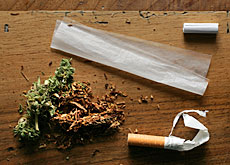
Swiss struggle to kick drug habit

A new method for analysing cocaine abuse places four Swiss towns and cities – St Moritz, Zurich, Basel and Bern – among the world's top 20 coke capitals.
A UN report containing the findings also notes that Swiss cannabis consumption and production remains among the highest in Europe.
Tests on wastewater carried out by a German institute show that an estimated 22 lines of cocaine are consumed daily per 1,000 inhabitants over the age of 15 in St Moritz.
The mountain resort, which ranked sixth behind global leader New York (134 lines), outstripped London, Madrid and Paris – plus the three Swiss cities.
Responding to the findings in the 2007 World Drug Report, Swiss police officials denied that the ski destination, which is favoured by the jet set, had a cocaine problem.
“Last year we conducted a major operation and arrested three dealers and 40 users, but it’s no worse than in other places. We think the situation is under control,” canton Graubünden police spokesman Daniel Zinsli told swissinfo.
Cocaine abuse
Janine Messerli, spokeswoman for the Swiss Institute for the Prevention of Drug and Alcohol Problems, said there were clear indications that cocaine consumption was increasing in Switzerland. She said greater availability and cheaper prices were among the factors behind this rise.
“Experts who work in treatment and counselling are seeing more people with cocaine problems,” said Messerli. “We also know from police data on how much cocaine has been seized that cocaine is becoming a more important issue.”
The annual report from the Vienna-based UN Office on Drugs and Crime (UNODC) also showed once again that the Swiss are among the biggest consumers of cannabis in Europe.
Almost one in ten 15-64 year olds use the drug, putting Switzerland in fourth place behind Cyprus, Italy and Spain, said the agency.
Cannabis production
And it is not simply a question of consumption. The report noted that “significant amounts” of cannabis are being grown in Switzerland.
The UNODC figures are based on data from 2003, but a more recent study published earlier this year by the Institute for the Prevention of Drug and Alcohol Problems indicates that Swiss youngsters are losing their taste for the drug.
The report, published in February this year, showed a fall in cannabis consumption last year among 15 year olds – stopping the upward trend of the last 20 years.
In 2006 around a third of boys and 27 per cent of girls aged 15 admitted having tried the drug at least once. In 2002 – the highest ever rate – it was 46 per cent for boys and 37 per cent for girls.
“Certainly among young people, the indications are there that cannabis consumption is falling. We are now in the process of collecting new data for adults,” said Messerli.
UN report
The annual UN report found that the production, trafficking and consumption of illicit drugs – apart from opium – have largely stabilised globally and that the estimated level of global drug use has remained more or less unchanged for the third year in a row.
Approximately 200 million people – or five per cent of the world’s population aged between 15 and 64 – used drugs at least once in the previous 12 months, it said.
Of those, an estimated 25 million – or 0.6 per cent of the global population were so-called problem drug users, or individuals who are heavily drug dependent. That estimate also remained unchanged.
“Recent data show that the runaway train of drug addiction has slowed down,” noted Antonio Maria Costa, executive director of the UN drug office.
swissinfo, Adam Beaumont
Afghanistan produced dramatically more opium in 2006, increasing its yield by roughly 49% from a year earlier and pushing global opium production to a new record high.
Cannabis continues to account for the vast majority of illegal drug use and is consumed by some 160 million people, though recent estimates have declined.
Amphetamine-type stimulants, including ecstasy, remain the second-most widely consumed group of substances. Over the 2005-2006 period, some 25 million people are estimated to have used amphetamines at least once in the previous 12 months, about the same as a year earlier.
Global cocaine production is estimated to have remained basically unchanged in 2006 compared to one or two years earlier.

In compliance with the JTI standards
More: SWI swissinfo.ch certified by the Journalism Trust Initiative





























You can find an overview of ongoing debates with our journalists here . Please join us!
If you want to start a conversation about a topic raised in this article or want to report factual errors, email us at english@swissinfo.ch.